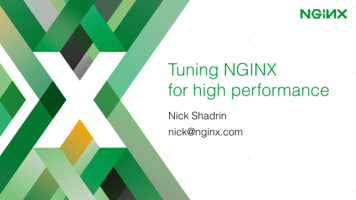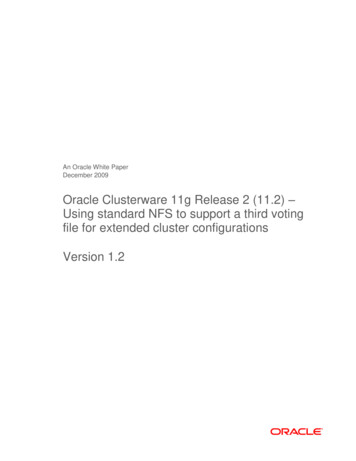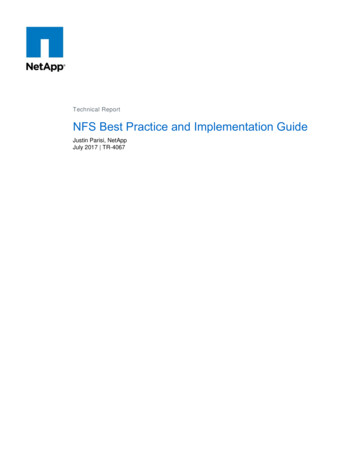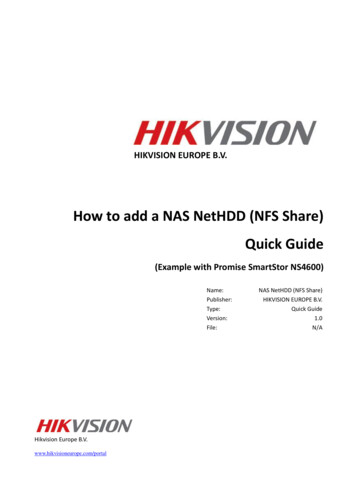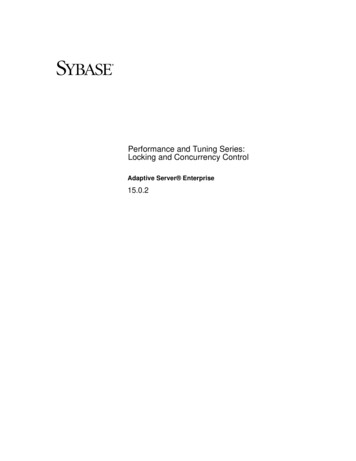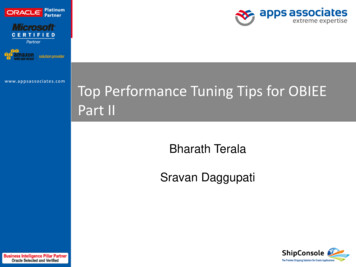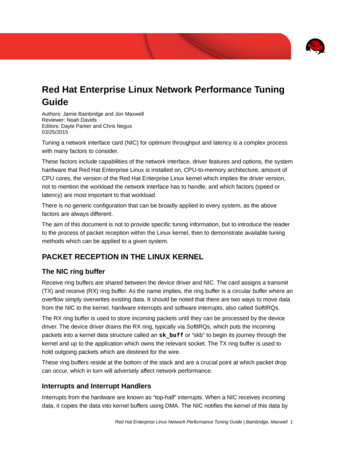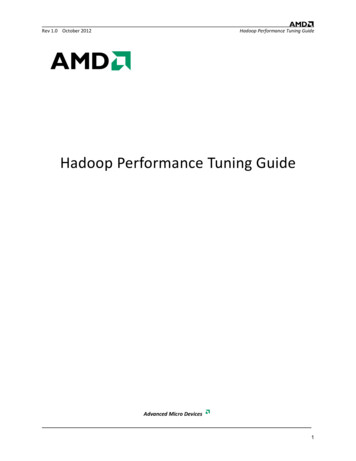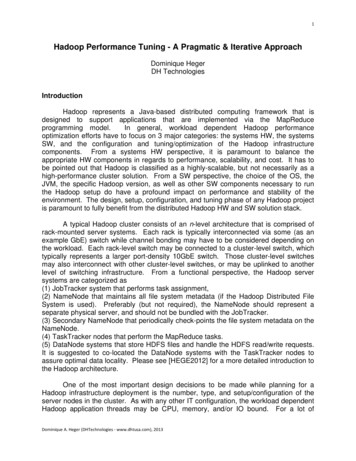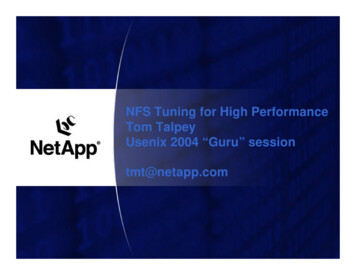
Transcription
NFS Tuning for High PerformanceTom TalpeyUsenix 2004 “Guru” sessiontmt@netapp.com
Overview4Informal session!4General NFS performance concepts4General NFS tuning4Application-specific tuning4NFS/RDMA futures4Q&A
Who We Are4Network Appliance4“Filer” storage server appliance family– NFS, CIFS, iSCSI, Fibre Channel, etc– Number 1 NAS Storage Vendor – NFSFAS900 SeriesUnifiedEnterpriseclass storage NearStoreEconomicalsecondarystoragegFiler Intelligentgateway forexistingstorageNetCache Acceleratedand secureaccess to webcontentFAS200 SeriesRemote andsmall officestorage
Why We CareWhat the User Purchases and DeploysAn NFS SolutionLinux, Solaris, AIX,HPUX ProductNetApp ProductUNIX HostNFS ClientNetApp FilerNFS Server
Our Message4NFS à Delivers real management/cost value4NFS à Core Data Center4NFS à Mission Critical Database Deployments4NFS à Deliver performance of Local FS ?4NFS à Compared directly to Local FS/SAN
Our Mission4Support NFS Clients/Vendors We are here to help4Ensure successful commercial deployments Translate User problems to actionable plans4Make NFS as good or better than Local FS This is true under many circumstances already4Disseminate NFS performance knowledge Customers, Vendors, Partners, Field, Engineers
NFS Client Performance4Traditional Wisdom NFS is slow due to Host CPU consumption Ethernets are slow compared to SANs4Two Key Observations Most Users have CPU cycles to spare Ethernet is 1 Gbit 100 MB/s. FC is on 2x
NFS Client Performance4Reality – What really matters Caching behaviorWire efficiency (application I/O : wire I/O)Single mount point parallelismMulti-NIC scalabilityThroughput IOPs and MB/sLatency (response time)Per-IO CPU cost (in relation to Local FS cost)Wire speed and Network Performance
Tunings4The Interconnect4The Client4The Network buffers4The Server
Don’t overlook the obvious!4Use the fastest wire possible– Use a quality NIC (hw checksumming, LSO, etc)– 1GbE– Tune routing paths4Enable Ethernet Jumbo Frames– 9KB size reduces read/write packet counts– Requires support at both ends– Requires support in switches
More basics4Check mount options– Rsize/wsize– Attribute caching Timeouts, noac, nocto, actimeo 0 ! noac (noac disables write caching)– llock for certain non-shared environments “local lock” avoids NLM and re-enables cachingof locked files can (greatly) improve non-shared environments,with care– forcedirectio for databases, etc
More basics4NFS Readahead count– Server and Client both tunable4Number of client “biods”– Increase the offered parallelism– Also see RPC slot table/Little’s Law discussion later
Network basics4Check socket options–––––System default socket buffersNFS-specific socket buffersSend/receive highwatersSend/receive buffer sizesTCP Large Windows (LW)4Check driver-specific tunings– Optimize for low latency– Jumbo frames
Server tricks4Use an Appliance4Use your chosen Appliance Vendor’s support4Volume/spindle tuning– Optimize for throughput– File and volume placement, distribution4Server-specific options– “no access time” updates– Snapshots, backups, etc– etc
War Stories4Real situations we’ve dealt with4Clients remain Anonymous– NFS vendors are our friends– Legal issues, yadda, yadda– Except for Linux – Fair Game4So, some examples
Caching – Weak Cache Consistency4 Symptom Application runs 50x slower on NFS vs Local4 Local FS Test dd if /dev/zero of /local/file bs 1m count 5See I/O writes sent to diskdd if /local/file of /dev/nullSee NO I/O reads sent to diskData was cached in host buffer cache4 NFS Test dd if /dev/zero of /mnt/nfsfile bs 1m count 5See I/O writes sent to NFS serverdd if /local/file of /dev/nullSee ALL I/O reads send to disk ?!?Data was NOT cached in host buffer cache
Caching – Weak Cache Consistency4 Actual Problem Threads processing write completions Sometimes completed writes out-of-order NFS client spoofed by unexpected mtime in post-opattributes NFS client cache invalidated because WCC processingbelieved another client had written the file4 Protocol Problem ? Out-of-order completions makes WCC very hard Requires complex matrix of outstanding requests4 Resolution Revert to V2 caching semantics (never use mtime)4 User View Application runs 50x faster (all data lived in cache)
Oracle SGA4Consider the Oracle SGA paradigm Basically an Application I/O Buffer CacheConfiguration 1Host Main MemoryConfiguration 2Host Main MemoryOracle Shared Global AreaOracle Shared Global AreaHost Buffer CacheHost Buffer Cache4 Common w/32 bit Arch4 Common w/64 bit Arch4 Or Multiple DB instances4 Or Small Memory Setups
Oracle SGA – The “Cache” Escalation4With Local FS4With NFSHost Main MemoryHost Main MemoryOracle Shared Global AreaOracle Shared Global AreagniHost Bufferh CachecCaI/OgnihHost Buffer cCacheCaI/ONO4 Very Little Physical I/O4 Lots of Physical I/O4 Application sees LOW latency4 Application sees HIGH latency
File Locks4 Commercial applications use different locking techniques No LockingSmall internal byte range lockingLock 0 to End of FileLock 0 to Infinity (as large as file may grow)4 NFS Client behavior Each client behaves differently with each typeSometimes caching is disabled, sometimes notSometimes prefetch is triggered, sometimes notSome clients have options to control behavior, some don’t4 DB Setups differ from Traditional Environment Single host connected via 1 or more dedicated links Multiple host locking is NOT a consideration
File Locks4Why does it matter so much? Consider the Oracle SGA paradigm againConfiguration 1Host Main MemoryConfiguration 2Host Main MemoryOracle Shared Global AreaOracle Shared Global AreaHost Buffer CacheHost Buffer Cache4 NOT caching here is deadly4 Caching here is a waste of resources4 Locks are only relevant locally4 Simply want to say “don’t bother”
Cache Control Features4Most of the NFS clients have no “control” Each client should have several “mount” options– (1) Turn caching off, period– (2) Don’t use locks as a cache invalidationclue– (3) Prefetch disabled4Why are these needed Application needs vary Default NFS behavior usually wrong for DBs System configurations vary
Over-Zealous Prefetch4Problem as viewed by User Database on cheesy local disk– Performance is ok, but need NFS features Setup bake-off, Local vs NFS, a DB batch job– Local results: Runtime X, disks busy NFS Results– Runtime increases to 3X4Why is this?– NFS server is larger/more expensive– AND, NFS server resources are SATURATED– ?!? Phone rings
Over-Zealous Prefetch4 Debug by using a simple load generator to emulate DB workload4 Workload is 8K transfers, 100% read, random across large file4 Consider I/O issued by application vs I/O issued by NFS clientLatency8K 1 Thread8K 2 Thread8K 16 Thread19.97.9510.6App Ops NFS 4K ops9254931499062157232388157690NFS 32K ops4Kops/App Op 32K ops/App op09855800192.33.515.94 NFS Client generating excessive, unneeded prefetch4 Resources being consumed needlessly4 Client vendor was surprised. Created a patch.4 Result: User workload faster on NFS than on Local FS0.01.18.1
Poor Wire Efficiency – Some Examples4Some NFS clients artificially limit operationsize Limit of 8KB per write on some mount options4Linux breaks all I/O into page-size chunks If page size rsize/wsize, I/O requests may besplit on the wire If page size rsize/wsize, operations will be splitand serialized4The User View No idea about wire level transfers Only sees that NFS is SLOW compared to Local
RPC Slot Limitation4Consider a Linux Setup Beefy server, large I/O subsystem, DB workload Under heavy I/O load– Idle Host CPU, Idle NFS server CPU– Throughput significantly below Wire/NICcapacity– User complains workload takes too long torun4Clues Using simple I/O load generator Study I/O throughput as concurrency increases Result: No increase in throughput past 16threads
RPC Slot Limitation4 Little’s Law I/O limitation explained by Little’s Law Throughput is proportional to latency and concurrency To increase throughput, increase concurrency4 Linux NFS Client RPC slot table has only 16 slots At most 16 outstanding I/O’s per mount point, even whenthere are hundreds of disks behind that mount point Artificial Limitation4 User View Linux NFS performance inferior to Local FS Must Recompile kernel or wait for fix in future release
Writers Block Readers4Symptom Throughput on single mount point is poor User workload extremely slow compared toLocal No identifiable resource bottleneck4Debug Emulate User workload, study resultsThroughput with only Reads is very highAdding a single writer kills throughputDiscover writers block readers needlessly4Fix Vendor simply removed R/W lock whenperforming direct I/O
Applications Also Have Issues4Some commercial apps are “two-brained”– Use “raw” interface for local storage– Use filesystem interface for NFS storage– Different code paths have major differences Async I/O Concurrency settings Level of code optimization4Not an NFS problem, but is a solution inhibitor
Why is this Happening?4Is NFS a bad solution? Absolutely not!4NFS began with a specific mission Semi-wide area sharing Home directories and shared data4Note: problems are NOT with NFS protocol Mostly client implementation issues4Are the implementations bad?
Why is this Happening?4The implementations are NOT bad.4The Mission has changed! Narrow sharing environmentTypically dedicated (often p2p) networksData sharing à High-speed I/O InterconnectMission evolved to Mission Critical Workloads4Actually, NFS has done ok Credit a strong protocol design Credit decent engineering on theimplementations
Why are things Harder for NFS?4What makes Database NFS different thanLocal FS?– For Local Filesystem Caching is simple Just do it No multi-host coherency issues– NFS is different By default must be concerned about sharing Decisions about when to cache/not, prefetch/not
Why are things Harder for NFS?4Database Filesystem Caching is complex– Most database deployments are single host(modulo RAC) So, cross host coherency not an issue However, Users get nervous about relaxing locks– Databases lock files (many apps don’t) Causes consternation for caching algorithms– Databases sometimes manage their own cache (alaOracle SGA) May or may not act in concert with host buffercache
Whitepaper on Solaris, NFS, and Database4Joint Sun / NetApp White Paper– NFS and Oracle and Solaris and NetApp– High level and Gory Detail both4Title– Database Performance with NAS: Optimizing Oracleon NFS4Where– http://www.sun.com/bigadmin/content/nas/sun netapps rdbms wp.pdf– (or http://www.netapp.com/tech library/ftp/3322.pdf)Darrell
NFS Performance ConsiderationsNFS ImplementationNetwork Configuration– Up-to-date Patch levels– NFS Clients – Not all Equal Strengths/Weaknesses/Maturity– NFS Servers NetApp filers – mostadvanced– Topology – Gigabit, VLAN– Protocol Configuration UDP vs TCP Flow Control Jumbo Ethernet FramesNFS Configuration– Concurrency andPrefetching– Data sharing and file locking– Client caching behaviorHigh PerformanceI/OInfrastructure
NFS Scorecard – What and Why4Comparison of all NFS clients On all OS platforms, releases, NICs4Several major result categories Out of box basic performance– Maximum IOPs, MB/s, and CPU Cost of NFSvs Local– Others Well-Tuned Basic Performance Mount Features Filesystem Performance and Semantics Wire Efficiency Scaling / Concurrency Database Suitability
NFS Scorecard - caveat4This is a metric, not a benchmark or measureof goodness4“Goodness” is VERY workload-dependent4For example– High 4KB IOPS is key metric for databases– But possibly not for user home directories– Low overhead is also key, and may not correlate4But this is a start
NFS Scorecard – IOPs and MB/sIOPs4 4K IOPs Out-of-boxOS/NIC
NFS Scorecard – IOPs and MB/sIOPs4 64K MB/s Out-of-boxOS/NIC
NFS Scorecard – Costs4 4K and 8K Cost per I/O – NFS / LocalIOPs4 Bigger is Worse!OS/NIC
SIO – What and Why4What is SIO?– A NetApp authored tool Available through support channel– Not magic. Similar tools exist. Just useful.– Simulated I/O generator Generate I/O load with specifics:– read/write mix, concurrency, data set size– I/O size, random/sequential Works on all devices and protocols: files, blocks,iscsi Reports some basic results– IOPs, MB/s (others also)
SIO – What and Why (cont)4Why use SIO?–––––Controlled workload is imperativeSame tool on all platformsEmulate multiple scenariosEasy to deploy and runBetter than dd – single threaded (most cases) cp – who knows what is really happening real world setup – often hard to reproduce– Demonstrate performance for Users, validation, bounding maximum– Find performance bottlenecks
NFS Futures – RDMA
What is NFS/RDMA4A binding of NFS v2, v3, v4 atopRDMA transport such as Infiniband,iWARP4A significant performanceoptimization4An enabler for NAS in the high-end– Databases, cluster computing, etc– Scalable cluster/distributed filesystem
Benefits of RDMA4Reduced Client Overhead4Data copy avoidance (zero-copy)4Userspace I/O (OS Bypass)4Reduced latency4Increased throughput, ops/sec
Inline ReadClientSend DescriptorServerREAD -chunksREAD DescriptorServerBufferREPLY2REPLYSend Descriptor
Direct Read (write chunks)ClientSend DescriptorServerREAD chunksREAD chunks1ReceiveDescriptorApplicationBufferRDMA Write2ServerBufferREPLYReceiveDescriptor3REPLYSend Descriptor
Direct Read (read chunks) – Rarely usedClientSend DescriptorServerREAD -chunksREAD -chunks1ReceiveDescriptorREPLY chunks2ReceiveDescriptorREPLY chunksApplicationBufferRDMA ReadServerBuffer3RDMA DONERDMA DONE4Send Descriptor
Inline WriteClientSend DescriptorServerWRITE -chunksWRITE ufferREPLY2ReceiveDescriptorREPLYSend Descriptor
Direct Write (read chunks)ClientSend DescriptorServerWRITE chunksWRITE chunks1ReceiveDescriptorApplicationBuffer2RDMA ReadServerBufferREPLYReceiveDescriptor3REPLYSend Descriptor
NFS/RDMA Internet-Drafts4IETF NFSv4 Working Group4RDMA Transport for ONC RPC– Basic ONC RPC transport definition for RDMA– Transparent, or nearly so, for all ONC ULPs4NFS Direct Data Placement– Maps NFS v2, v3 and v4 to RDMA4NFSv4 RDMA and Session extensions– Transport-independent Session model– Enables exactly-once semantics– Sharpens v4 over RDMA
ONC RPC over RDMA4Internet Draft– draft-ietf-nfsv4-rpcrdma-00– Brent Callaghan and Tom Talpey4Defines new RDMA RPC transport type4Goal: Performance– Achieved through use of RDMA for copy avoidance– No semantic extensions
NFS Direct Data Placement4Internet Draft– draft-ietf-nfsv4-nfsdirect-00– Brent Callaghan and Tom Talpey4Defines NFSv2 and v3 operations mapped toRDMA– READ and READLINK4Also defines NFSv4 COMPOUND– READ and READLINK
NFSv4 Session Extensions4Internet Draft– draft-ietf-nfsv4-session-00– Tom Talpey, Spencer Shepler and Jon Bauman4Defines NFSv4 extension to support:––––Persistent Session associationReliable server reply caching (idempotency)Trunking/multipathingTransport flexibility E.g. callback channel sharing w/operations Firewall-friendly
Others4NFS/RDMA Problem Statement– Published February 2004– /RDMA Requirements– Published December 2003
Q&A4Questions/comments/discussion?
4“Filer” storage server appliance family – NFS, CIFS, iSCSI, Fibre Channel, etc – Number 1 NAS Storage Vendor – NFS FAS900 Series Unified Enterprise-class storage NearStore Economical secondary storage NetCache Accelerated and secure access to web content gFiler Intelligent
